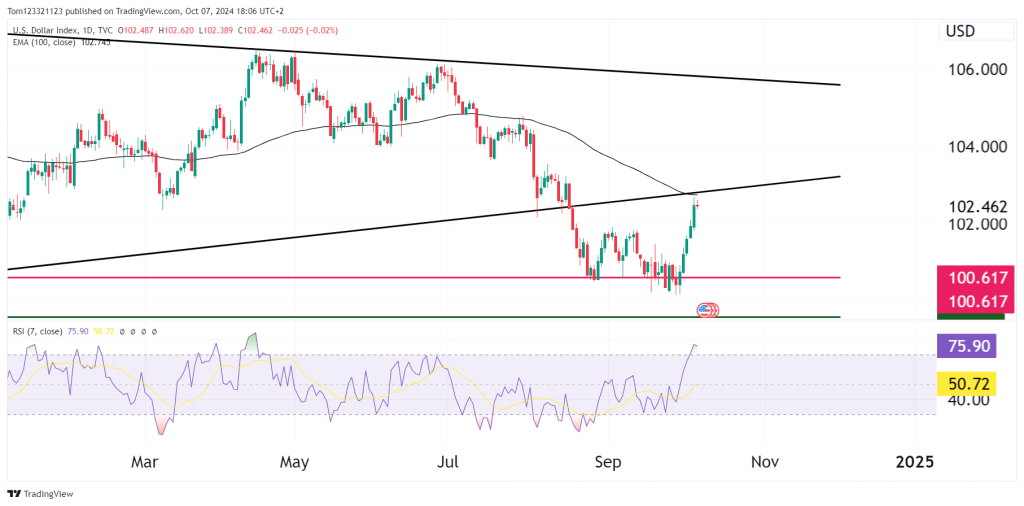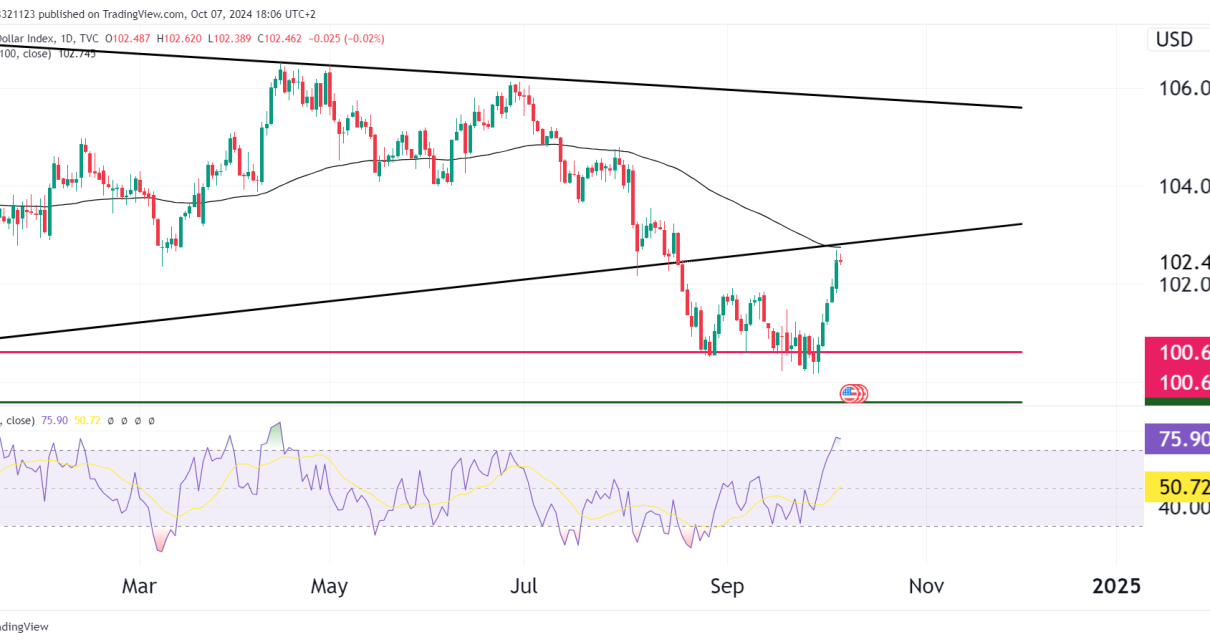Introduction
The Dollar has been surging for the past few sessions, posting five straight green candles. Without looking at any fundamentals in today’s overview, lets dive straight into the technicals and see what we can find.
Technical Analysis
The Dollar is overextended in the short term with the RSI in overbought territory. Price has also hit the resistance level, which was the earlier symmetrical triangle that started its formation in July of last year. The price is also testing the 100 moving average and will all be down to what the Fed does next but in the short term we can predict certain moves in the Dollar before hand.

It is possible that we see price drop down again and reject this resistance level and test the 100.617 level which from there would be very interesting to see if the bulls or bears are stronger.
It is also likely that we see price remain sideways for some time now after this strong surge.
Implications for U.S. Equities
Equity Market Pressure:
- Rising DXY = Downward Pressure on U.S. Equities: Historically, a stronger dollar tends to act as a headwind for U.S. equity markets, particularly for multinational companies with significant revenue exposure outside of the U.S. When the dollar strengthens, it makes U.S. exports more expensive and can negatively impact earnings growth. The bounce from the 100.8 level in the DXY signals that if the dollar continues to rally, we may see pressure on major U.S. indices like the S&P 500, Nasdaq, and Dow Jones.
Sector-Specific Impact:
- Technology and Consumer Discretionary: These sectors are particularly sensitive to a stronger dollar, as many of these companies generate a large portion of their revenue abroad. A stronger dollar would lead to foreign revenues translating into fewer U.S. dollars, potentially negatively impacting earnings.
- Financials and Industrials: If the DXY breaks higher, it may provide some support to sectors like financials, as a stronger dollar often aligns with higher interest rates, which generally benefit financial institutions. However, a stronger dollar could weigh on industrials with global exposure.
Implications for Commodities:Bearish for Commodities:
- Stronger Dollar = Bearish for Commodities: Commodities like oil, gold, and copper are priced in U.S. dollars, meaning that when the dollar rises, these commodities tend to fall in price. The recent bounce from support levels in the DXY could therefore signal short-term weakness in commodities. A breakout above 102.5 in the DXY would likely exacerbate this pressure, causing commodities to correct lower.
- Gold and Precious Metals: The RSI on the DXY is not yet oversold, so a further dollar rally could weigh on gold prices, which typically move inversely to the U.S. dollar. A stronger DXY would likely push gold back down from its recent highs, and silver and other precious metals would follow suit.
- Oil and Energy: Rising DXY could also negatively impact oil prices, as a stronger dollar makes oil more expensive in other currencies. This could dampen demand and lead to a correction in crude oil prices, especially given the importance of the dollar in international oil markets.
Bullish Scenario for Commodities:
- If the DXY fails to move higher and turns back lower, commodities could find renewed strength. Oil, gold, and other raw materials would likely see bullish momentum if the dollar weakens from current levels.
Broader Implications for the Global Economy:
Emerging Markets:
- Emerging market equities and debt are particularly sensitive to the U.S. dollar’s movements. A stronger DXY would put pressure on these markets as their debt obligations become more expensive, and it typically leads to capital outflows from these regions.
Inflation and Interest Rates:
- A stronger dollar could help cool inflationary pressures within the U.S. by reducing the cost of imports, which in turn might give the Federal Reserve some room to pause interest rate hikes. Conversely, a weaker dollar might put renewed pressure on inflation, forcing central banks to keep rates higher for longer.



